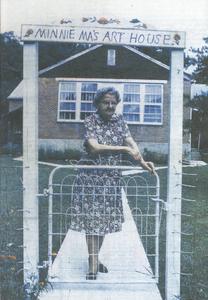

Minnie Ma Scyphers is shown at the gate of her "Art House."
ABINGDON, VA - Minnie Ma Scyphers' "Untitled" (Watermills from around Southwest Virginia) from William King Museum's permanent collection has been nominated for Virginia's Top 10 Endangered Artifacts program.
Hosted by the Virginia Association of Museums, Virginia's Top 10 Endangered Artifacts program is part of the Virginia Collections Initiative, which is a statewide collaboration to ensure the ongoing safety and stewardship of collections, held by museums, libraries and archives in Virginia and D.C. The Top 10 program raises awareness about the need for collections care while showcasing the importance of Virginia's diverse history, heritage and art and the role that objects play in telling those stories.
Throughout August, public voting is being held for all of the artifacts accepted as nominations in this year's program. Voting will determine the People's Choice Award. To vote, \ visit www.vamuseums.org and look for the Vote option on the left-hand side of the page. After a peer panel review in early September, the Top Ten Most Endangered Artifacts will be determined. If it is chosen, "Untitled" (Watermills from around Southwest Virginia) will have the opportunity to be preserved by specialists.
Curator Leila Cartier chose to submit "Untitled" (Watermills from around Southwest Virginia) to the program for several reasons. "This piece was so fragile when it was first displayed at the Museum that we had to place it behind Plexiglas," Cartier said. "Nearly all aspects of the materials are breaking away from the original panel that Minnie Ma used to arrange this ambitious project."
"Untitled" (Watermills from around Southwest Virginia) is comprised of 16 small paintings that have been adhered to a flimsy piece of wood paneling, a material that can be found in older and less expensive homes in place of drywall. The brown tape that surrounds each painting was used as an effort to frame and secure each image in place because Scyphers did not have access to better materials.
"Preserving our cultural heritage is central to the mission of William King Museum," said Cartier. "Folk Art is unlike most other art forms because it often develops in remote, rural communities. Minnie Ma's materials were not made to stand the test of time, but her story and pictures were. This piece was recovered from Minnie Ma's Art House, which was once part of our local landscape but is now vacant. Even though she was tucked away in Brumley Gap, she lived an incredible life full of local character."
Scyphers is one of the most prolific yet hardly known folk artists from the Appalachian Mountains of Southwest Virginia. She was born into abject poverty and raised in Hayter's Gap in Washington County, Va. It was not until in her 70s that she moved into the old Brumley Gap School and began her artistic life. Scyphers created hundreds of paintings on anything she could find: cardboard, artist boards, wood paneling, the backs of puzzle boxes and other surfaces would be covered over with painted pictures. She put many of these paintings in frames, and if one wasn't available, she crafted one with gold paint or tape. Minnie Ma's paintings are primarily of homes, churches and other buildings settled amidst the bucolic landscape of the Appalachian Mountains. After her death in 2010, her descendants donated 20 paintings to the William King Museum Cultural Heritage Collection.
"Minnie Ma has a fascinating story that tells of her great tenacity and humble character," Cartier said. "Late in her life she created around 600 paintings of local landscapes with no formal instruction or significant purpose other than to create. This piece was clearly important to her because of the dedication she put in to rendering each of the 16 watermills."
For more information about this or other cultural heritage items at the William King Museum, visit www.williamkingmuseum.org or call 276-628-5005.